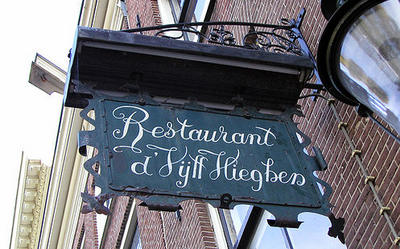
In Search of the Characters of New York
By RANDY KENNEDY
If you are not the sort of person who cares deeply about the Old World subtleties of Fournier, the retro-hipster swirl of Ministry Script or the plain-vanilla, rock-ribbed dependability of Helvetica - nor the sort immediately able to identify the typeface you are reading right now as 8.7-point Imperial - then you were probably not aware that Mayor Michael R. Bloomberg declared this week Type Week in New York City.
You also might have assumed that a group of a dozen people wandering around the Upper East Side on Thursday morning, snapping pictures of the unremarkable words "Public School 6" inscribed into stone above an unremarkable red door on East 81st Street were tourists in possession of a badly translated guidebook.
But they were actually admiring the inscription on purpose, remarking on its clean Bauhaus roots. And a few blocks away, they gave the third degree to the neo-Roman letters carved along the top of Regis High School.
"The 'R' is too small in the bowl, and too long in the leg," complained Paul Shaw, a New York type designer and calligrapher who was leading the group on what he called a letter-form tour of Manhattan, with stops to take in the Art Deco Bloomingdale's sign, the sputnik-esque Frank Lloyd Wright letters on the Guggenheim Museum and the work of Bruce Rogers, a demigod of American book design, in the form of a huge Emerson quotation adorning a wall of Hunter College.
These pilgrims were among about 500 people, some from as far away as Brazil and Finland, who have converged on the city for TypeCon, a yearly gathering of typographers, printers, designers, calligraphers and assorted, self-described font freaks and type nerds who can argue about kerning into the wee hours.
If nothing else, TypeCon, now in its eighth year, sets out to prove that the typographical crowd, despite its two-dimensional obsessions, can partake in all the three-dimensional joys of any conventioneers. The activities include a film festival (sample past title: "Helvetica It Hurts"), a citywide typographic scavenger hunt with cash prizes and even a temporary radio station, set up inside the Parsons School of Design on West 12th Street. ("Type is speech on paper," the station's slogan goes. "Typeradio is speech on type." The D.J.'s say, however, that it has not proved particularly exciting to talk about type, so conversation on the station, accessible on the Web at www.typeradio.org, has tended toward music, food and sex.)
"We do compare this to a Trekkie convention sometimes," said Tamye Riggs, the executive director of the Society of Typographic Aficionados, which organized the event. "People can get really obsessed about it."
But type types don't wear costumes like Trekkies or Civil War re-enactors. Instead, they often wear really cool T-shirts and designer eyeglasses and hand out exquisitely designed business cards on heavy card stock. Their conversation can quickly descend into the slightly self-satisfied jargon of any specialty, with talk of uncial script, ligatures and serif slants, along with frequent references to Trajan's Column in Rome, an ancient source of Western letter forms.
But unlike many kinds of buffs, they are quick to try to share their enthusiasm and knowledge with even the most ill-informed typographical philistine (who has never changed the typeface on his word-processing program and had no idea until he looked it up yesterday that his newspaper's body type was 8.7-point Imperial.)
"Bloomies!" Mr. Shaw exclaimed, raising both his hands like a religious supplicant as he emerged from a subway staircase on Thursday morning and caught sight of the Bloomingdale's sign, with its boxy letters, ended by a cartoonlike "s" that seems to have wandered over from a Disney movie.
"The 's' is so funky," said Craig Brown, a New Jersey graphic designer, who took the tour with others from San Francisco, São Paulo, Calgary, Pensacola, Fla., and Redding, England. "It's so out of place."
Mr. Shaw, bearded, with long graying hair and the zeal of the Ancient Mariner, led his followers at a furious pace from the Guggenheim all the way down to Madison Square Park, dipping in and out of the subway, where he showed examples of weird serifs in the tile work (the serifs on the middle bars of the "e's" on signs along the Lexington line lean from left to right, an odd variation that seems to connote speed), and revealed little-known subterranean typographical mistakes.
"Some of the 'h's' in the Borough Hall station in Brooklyn are upside down," he said. "The crossbar is in the wrong position. I think the workers had a drawing from the engineer, but - hey - they're working with tile and sometimes they were one line off."
At times on Thursday, passers-by would stop and stare, too, trying to figure out what all these serious-looking people were looking at. In front of Public School 6, a man paused, squinted at the red door and its seemingly prosaic inscription and then shook his head.
"Is there supposed to be something special here?" he asked.
Thanks to The New York Times Company Copyright 2005




























































